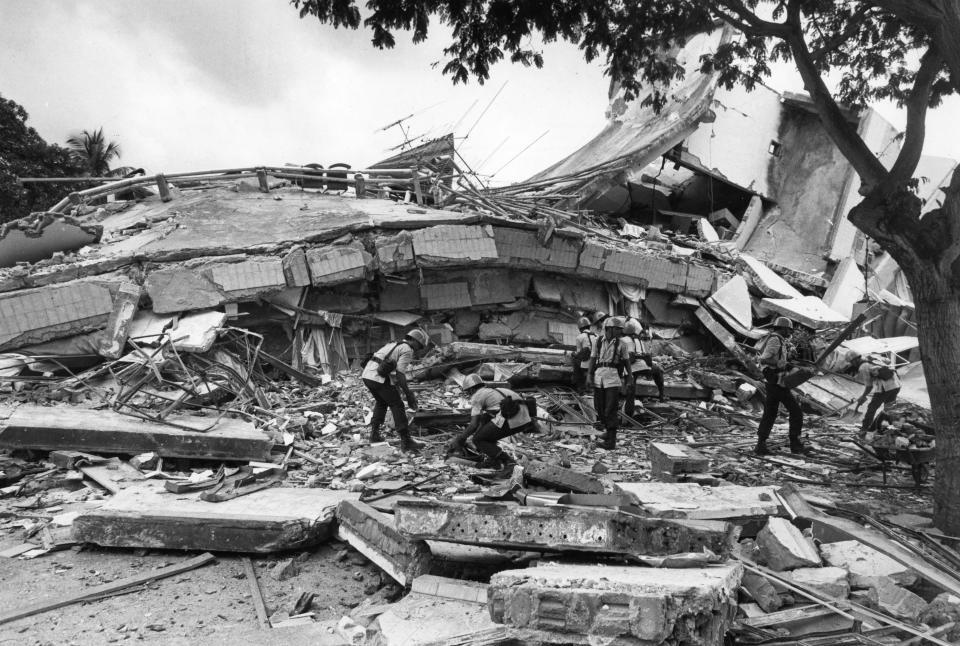Hotel New World: The day it fell
A Yahoo Singapore exclusive by Nicholas Yong and Safhras Khan. This is the first of a three-part series to mark the 30th anniversary of the Hotel New World disaster. Read part II and part III.
It’s been three decades since the Lian Yak Building, better known as Hotel New World, collapsed at about 11.15am on 15 March, 1986. But while Singapore’s first major civil disaster took place long before the age of social media and camera phones, memories of the disaster remain fresh in people’s minds.
Built between 1969 and 1971, the six-storey building stood at the junction of Owen Road and Serangoon Road. It was occupied by a nightclub, a branch of the Industrial & Commercial Bank and the 67-room Hotel New World. Today, theseven-storey Fortuna Hotel stands in its place.
Members of the public that Yahoo News Singapore approached in the area were mostly unaware of the collapsed building’s former location. But the glint of recognition came into their eyes the moment Hotel New World was mentioned.

“Oh yeah, the one that collapsed lah. Yeah, it collapsed and many people were stuck and died inside, “ said one elderly Indian gentleman. Almost all of the interviewees, aged between their early 20s and 70s, knew the basic facts of the incident.
Restaurant owner Ceejay Singh, then 26, was running a textile shop across the road from the hotel. On the day of the collapse, he had been shopping with a friend in High Street. “We heard some screaming and some shouting, and that something has collapsed,” recalled Singh.
He added, “We started running with other people towards this building, and we saw the building wasn’t here any more. Just a roof. Everything was under the roof.”
“I’d never seen anything like it before. It was like a demolition site. If it happened today… we’d be imagining it was a sort of terrorist act.”
- Former MRTC engineer David Stewart.
Koh Ah Lua, then 25, remembers a friend running into his spare parts shop at Race Course Road to break the news. He said, “The police had not showed up yet, so we went to take a closer look. I saw that many cars had been flattened. The situation was very tense.”
The one-week rescue and recovery operation that followed mobilised some 500 personnel from the Singapore Civil Defence Force, Singapore Police Force, Singapore Armed Forces and the now-defunct Singapore Fire Service. Tunneling experts from Ireland and the United Kingdom, who were working on the construction of the MRT line, played a crucial role in the rescue.

David Stewart, a senior resident engineer with the Mass Rapid Transit Corporation or MRTC (later renamed SMRT) at the time, was among the rescuers. He said, “I’d never seen anything like it before. It was like a demolition site. If it happened today… we’d be imagining it was a sort of terrorist act.”
According to the e-book “Resilience Through Heritage I: Hotel New World”, commissioned by the National Heritage Board, many of the rescue personnel were neither trained nor equipped to deal with a disaster of this scale. Fortunately, they were aided by specialised equipment, such as an ultra high pressure water machine that could blast through concrete without causing vibrations, and life detector devices.
“You are not just confronted with the mortality of people and human suffering, but you’re also confronted with your own mortality.”
- Volunteer rescuer Kelvin Tan
Much of the equipment was loaned by private companies and members of the public. Ordinary Singaporeans like singer-songwriter Kelvin Tan, who is a member of pioneering local band The Oddfellows, were also moved to volunteer their services. A full-time National Serviceman back then, he came to the site in the evenings with a friend, after completing their training in the day.
Tan, now 51, vividly remembers the long walk from the police cordon at the beginning of Little India, to the site itself, “The whole place was just isolated and deserted. And then there was a whole row of people at the right hand side. We were wondering why, and then we found out they were the relatives of the people who were stuck in the Hotel New World. They were waiting for results, which was really quite sad, because you see them crying and tense.”
Ultimately, 33 people perished and 17 were saved. A Commission of Inquiry appointed by former President Wee Kim Wee later concluded that the collapse was down to structural faults, and shoddy design and construction.
It led to the merging of the Singapore Civil Defence Force and the Singapore Fire Service, to ensure better coordination in rescue work. More stringent standards in the construction of buildings were also put in place.
The incident, said Tan, had a “profound” effect on him. “You are not just confronted with the mortality of people and human suffering, but you’re also confronted with your own mortality. You start to re-assess what your life should be, and I think in that sense, it’s changed the way I live,” he said. Tan even wrote a song about his experience.
Thirty years on, life has indeed gone on. Singh, who witnessed the aftermath of the disaster, has even opened a new restaurant on the first floor of the Fortuna Hotel. “What irony,” he said with a laugh.
This is the first of a three-part series to mark the 30th anniversary of the Hotel New World disaster. Read part II and part III.


